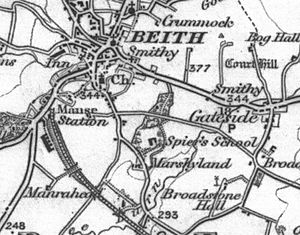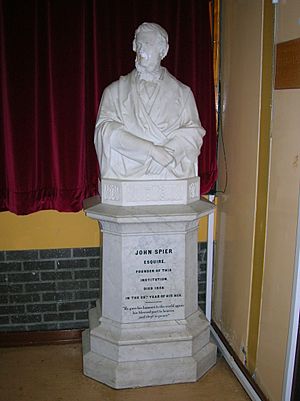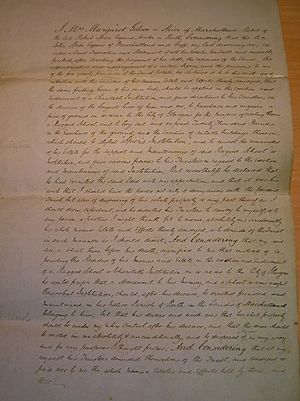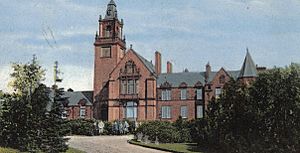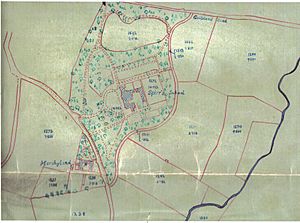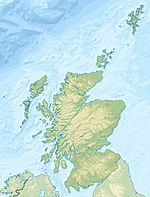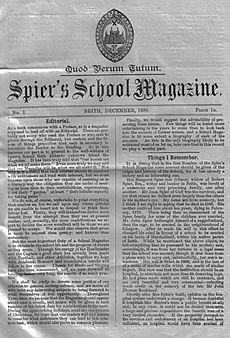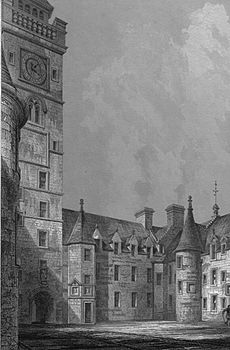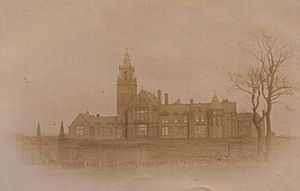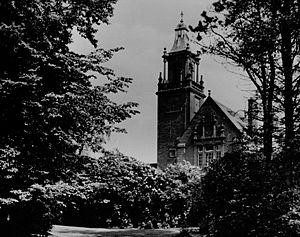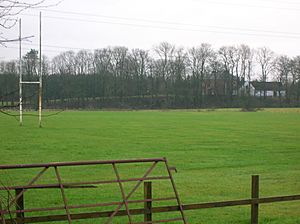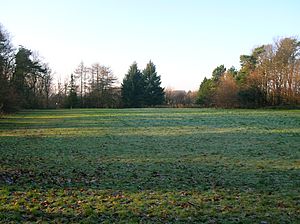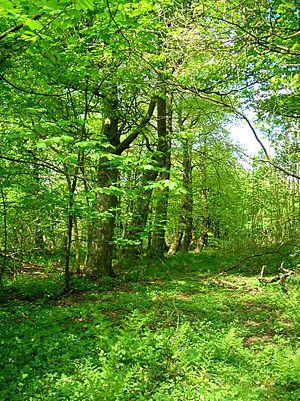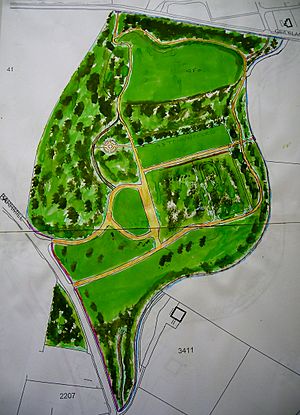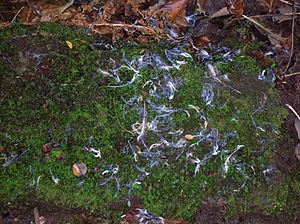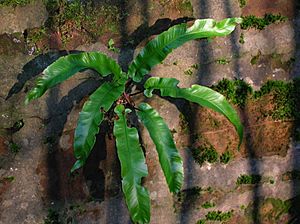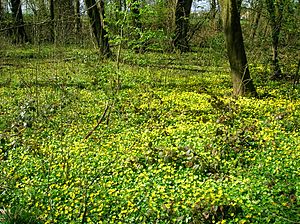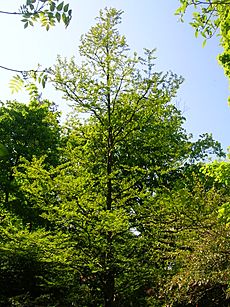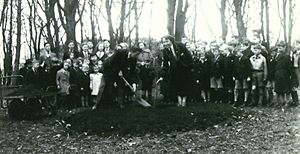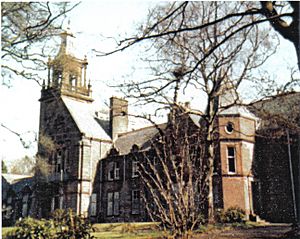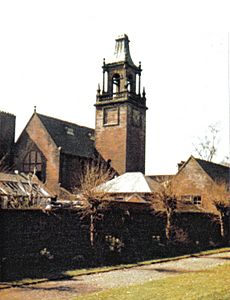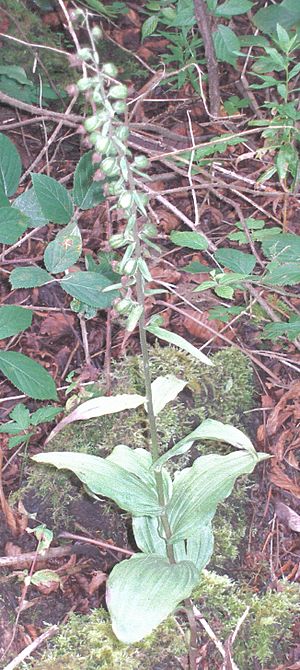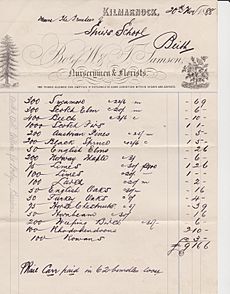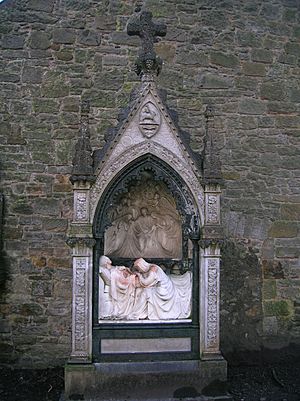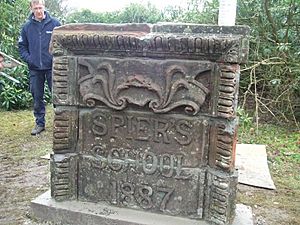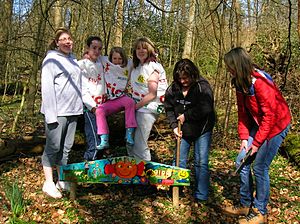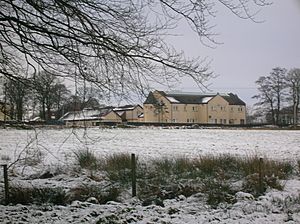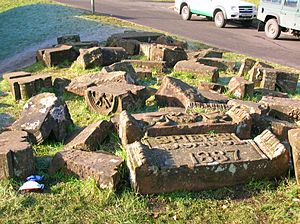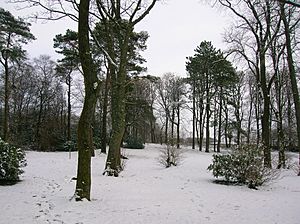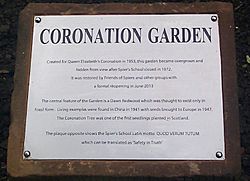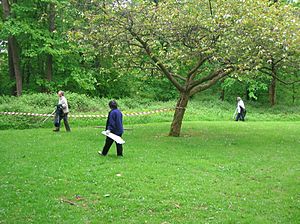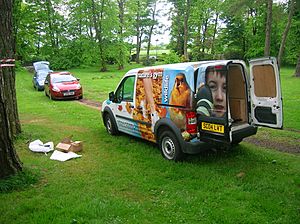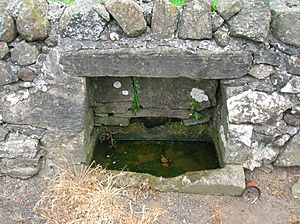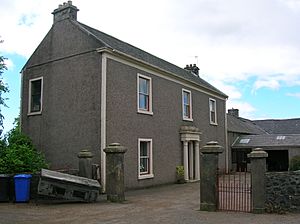Spier's School facts for kids
Quick facts for kids Spier's School |
|
|---|---|
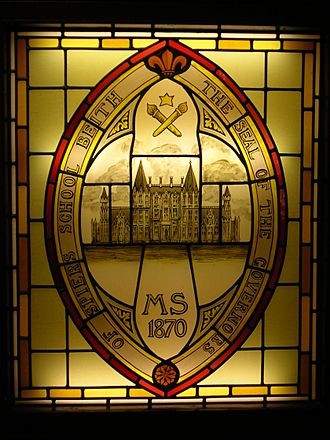
The Seal of the Governors of Spier's school. Note the 'old' architectural design - which was never used, and the date; some 18 years before the school opened. This item is now located at Beith Primary school.
|
|
| General information | |
| Address | KA15 1LU |
| Town or city | Beith, North Ayrshire |
| Country | Scotland |
| Coordinates | 55°44′42″N 4°37′30″W / 55.745°N 4.625°W |
| Construction started | September 1887 |
| Completed | September 1888 |
| Demolished | 1984 |
| Cost | £12,000 |
| Client | John Spier |
| Design and construction | |
| Architect | James Sellars |
Spier's School was a famous school in Beith, North Ayrshire, Scotland. It opened in 1888 and closed in 1972. The building was made of red sandstone and looked a bit like the old University of Glasgow. Its motto was 'Quod verum tutum', which means 'What is true is safe'. Even though the school is gone, its gardens and woodlands are still open for everyone to enjoy.
You can easily get to the school grounds by bike using Sustrans National Route 7 near Kilbirnie Lochside. Buses from Beith to Barrmill stop near the Barrmill Road entrance.
Contents
- The Marshalland Area
- How the School Started
- School Life and History
- The School Buildings
- School Sports
- The World Wars
- Gardens and Woodlands
- The Spier's Trust
- Diamond Jubilee Time Capsule
- The Spier's Cholera Pit
- Diamond Jubilee Wood
- The Spier's Labyrinth and War Memorial
- Natural History
- Wildlife Site Status
- North Ayrshire Council
- The Spier's Arboretum
- Leaflets and Online Information
- Memorials to John Spier and Spier's School
- Geilsland
- Gateside Village
- Industrial and Social History
- Geology of the Area
- DM Beith
- Marshalland Burn
- The Lands of Roughwood
- Small Historical Facts
- Restoration of Spier's Parklands
- Friends of Spier's (FoS)
- The Cuff
The Marshalland Area
The land where Spier's School was built is called Marshalland. In 1686, a man named John Shedden bought this land. Old maps show that the area was called "Marchland" in 1747. This name suggests it was on the edge, or 'march', of different land areas.
A local character named John Shedden, born in 1756, was known as 'Jack the Marsheland'. He was famous for poaching hares, which was against the law back then. He even had a friend fire a shotgun over his grave when he died!
Later, Robert Spier bought Marshalland. His son, John Spier, inherited it. John's father, Robert, was a successful businessman from Beith. He owned a lot of land and money.
In 1858, maps of the school site only showed two wells and the fields of Marshalland farm. The farm buildings were taken down in the early 1960s.
How the School Started
The idea for Spier's School came from John Spier. He died young in 1858. Before he passed away, he wished for his inheritance to be used to build a school. His mother, Margaret Gibson Spier, made sure his wish came true.
In 1869, Margaret set up a trust fund to build a charitable school. She wanted it to be for 24 children whose parents were not poor or tradesmen. She also said that teachers should not get married and had to retire at sixty.
When Margaret Spier died in 1870, she left £12,000 for the school. She also left money for other good causes in Beith. People in the area called her 'Lady' Spier.
There were some disagreements and delays about where to build the school. Eventually, it was decided to build it in Beith. The plan was for a school where both boys and girls could learn together. It would also have a few places for students to live there. The foundation stone for Spier's School was laid in September 1887. Over a thousand people came to the event!
School Life and History
Spier's School opened on September 22, 1888, with 140 students. Most students were from the local area. Robert Bruce Lockhart was the first headmaster. Students paid fees, but local children could get free education if they passed a test.
A small number of students lived at the school. They wore kilts on weekdays and special suits on Sundays. Boarding stopped during the First World War because of staff shortages.
Boys and girls were taught separately until 1893. The school motto was "Quod verum, tutum", meaning What is true is safe. New boys had a tradition of being thrown into the pond and then over a wall!
The school had financial problems by 1932. In 1936, the local education authority took over the school. The number of students grew to over 350 after new classrooms were added.
The school closed on June 30, 1972. This was because a new, bigger school, Garnock Academy, was opening nearby. Spier's School buildings became run down and were taken down in 1984.
Some of the old stone decorations from the school were saved. They are now at Garnock Academy and some have been moved back to the Spier's School grounds. The statue of John Spier and the rector's old table and chairs are also at Garnock Academy.
The School Buildings
The main entrance on Barrmill Road looks like buildings from the 1600s. It is a listed building, along with the boundary walls and other gates. The walls around the school grounds are very long, about 937 meters!
The school building had a 100-foot belltower, a hall, boardrooms, 10 classrooms, and a school-house. It was designed by James Sellars. The cost to build it was £12,000. An art room, gym, and science room were added in 1908. After 1945, four more classrooms were built.
Electricity was added when the education authority took over. Sadly, after the school closed in 1972, the buildings were damaged. They were all taken down in 1984.
People tried to find new uses for the buildings, like a country club or sports academy. But none of these plans worked out. The John Spier memorials were moved to Beith Kirk. The large statue of John Spier went to Garnock Academy.
School Sports
Spier's was well-known for its sports. It was the first school in Ayrshire to play rugby football! The first game was played in 1890. The school had three 'houses' – Cuff, Marshalland, and Spier. These houses competed against each other on sports days. Students also played tennis, cricket, hockey, netball, and golf.
The Old Spierian Football Club started in 1890. Later, it became the Old Spierian Rugby Club. When Spier's and Dalry schools closed in 1972, Garnock Rugby Club was formed. Some former Spier's students even played rugby for Scotland!
The Marshalland playing fields are now mostly used for football.
The World Wars
During the First World War, Spier's School had a cadet corps. They also gave money to help Belgian refugees. In the Second World War, part of the school's field was used to grow potatoes to help with food shortages.
Seventy former students from Spier's died in the World Wars. Their names were on war memorials inside the school. These memorials are now kept at the North Ayrshire Museum. The school also had a special Garden of Remembrance with roses and yew hedges.
- Role of honour for World War I and World War II
Gardens and Woodlands
The gardens and woodlands at Spier's are very special. The head gardener from Eglinton Country Park designed them. He planted many different trees and shrubs, especially holly. There were once 50 to 100 types of trees, all labeled with their names.
The walled garden was originally an orchard and kitchen garden. It had fruit trees like pears, apples, plums, and cherries. It also grew berries like gooseberries and raspberries.
A "Coronation Garden" was created in 1953. It featured a rare "living fossil" tree called the dawn redwood. This tree grows very slowly.
The woodland near Geilsland School was called the 'Ivy Palace' by students because of all the ivy. The grounds have many interesting plants, including different types of holly, cedar of Lebanon, and Rhododendron ponticum.
A strong boundary wall surrounds the 16-acre site. It was repaired by a volunteer in 2010-2011. The Spier's Trust also owns 48 acres of grazing land next to the school grounds.
The Powgree Burn, also known as the Geilsland Burn, runs through the area. Boys used to jump across it, and girls played in a nearby spot called the 'Fairy Glen'.
The Spier's Trust
The Spier's Trust was set up in 1991. It manages the Spier's grounds and gives money to students in the local area. The trust gets its money from investments and from renting out land for grazing. The trust committee meets twice a year to give out small grants to students. North Ayrshire Council now rents the school grounds from the trust for a very small fee.
Diamond Jubilee Time Capsule
In October 2011, students from Gateside Primary School buried a "Wish for the Future" time capsule. It is registered with the International Time Capsule Society. It will be opened on June 18, 2037, which is 150 years after the school's foundation.
The Spier's Cholera Pit
In the 1800s, there were outbreaks of cholera in Beith. Many people died. Some were buried in the churchyard, but others were buried in a field near where Spier's School was built. This was known as a cholera pit.
Diamond Jubilee Wood
In 2012, people from the local community planted a new wood at Spier's. This was to celebrate the Diamond Jubilee of Queen Elizabeth II. Beith Primary School helped plant over 400 trees.
The Spier's Labyrinth and War Memorial
Seventy former students from Spier's died in the World Wars. There was a War Memorial at the school, but it was lost when the school was demolished. In 2012, a group called Youth Making Beith Better (YMBB) created a new memorial. They placed an old Spier's gatepier in the former rose garden. They also built a labyrinth around it, which is a special path often used for quiet reflection.
Natural History
The Spier's grounds were once farmland. Today, they have many interesting plants, including several types of orchids. Ivy covers a large area near Geilsland Road.
Wildlife Site Status
The Scottish Wildlife Trust (SWT) has studied the grounds. They found 19 types of birds and 136 types of plants. There are also many different fungi. Because of its rich plant and animal life, the grounds are now an official SWT Wildlife Site. This helps protect the area.
In 2010, a rare tree called the Arran whitebeam was found at Spier's. In 2011, an extremely rare plant called common broomrape was discovered. It is now part of a conservation project.
The grounds are also a Local Biodiversity Site. Birdwatchers can see many birds here, like tits, finches, and woodpeckers.
North Ayrshire Council
Rangers from the North Ayrshire Ranger Service regularly patrol the grounds. The council's Streetscene team maintains the parkland. They mow grass and remove fallen trees.
In 2012, important people from North Ayrshire Council visited Spier's. They planted a copper beech tree to celebrate the community's restoration work.
The Spier's Arboretum
Before the school was built, the land was mostly open fields. In 1888, the school grounds were planted with many special trees and shrubs. This created an arboretum, which is like a tree museum.
An old list from 1888 shows that 3350 trees of seventeen different types were planted. They cost £9 16s 6d! Another list shows that 371 fruit trees and bushes were planted in the walled garden.
After the school closed in 1972, the grounds were not maintained as much. After the buildings were demolished in 1984, native trees like willow and birch grew where the school once stood.
In 2010, the North Ayrshire Ranger Service and the Friends of Spiers (FoS) started a restoration project. They created new paths and surveyed all 812 trees. They also planted new and exotic tree species.
The Spier's Arboretum will continue to grow with new trees like aspen, toffee apple trees, and monkey puzzle trees. There will be around fifty different tree species in total.
Leaflets and Online Information
A tree trail and leaflet were created in 2013 by the Youth Making Beith Better group. There is also a Facebook page called 'Spier's - Natural and Local History'. You can find visitor comments and photos on the TripAdvisor page for the grounds.
Memorials to John Spier and Spier's School
The John Spier memorial, a large stone sculpture, is now at Beith Auld Kirk. It was designed by Frederick Thomas Pilkington and sculpted by William Brodie.
The school is remembered in local names like 'Spiers Avenue' and 'Spiersland Way'. There is also a Spier's care home in Beith.
Beith Primary School has a 'Spier's Library'. It also has a painting of the school and a stained glass window showing an early design of the school that was never built. Gateside Primary School has a Spier's House and a Cuff House.
The old War Memorial from Spier's is stored at the North Ayrshire Museum. The large statue of John Spier was moved to Garnock Academy.
Geilsland
Geilsland is a nearby area. In 1867, William Fulton Love built a beautiful house there. This property is now part of Geilsland School. The name is pronounced 'Jillsland'.
Students from Geilsland have helped improve the Spier's grounds with conservation projects. In 2015, Geilsland School was sold to a local community trust.
Gateside Village
The village of Gateside is close to Spier's. It has a pub, a primary school, and a community hall. A large limestone quarry is nearby where Trearne House once stood.
Industrial and Social History
The Moot Hill
A 'Moot hill' or 'Court Hill' is a special mound near Boghall. It was used long ago by the Abbot of Kilwinning to hold court and make decisions. It is a flat-topped mound with large stones.
Quarrying
There was a sandstone quarry near Marshalland farm. Several large limekilns and limestone quarries were also in the area. Marble was found at Broadstone.
Broadstone Castle
The ruins of Broadstone Castle were still there until about 1850. Its stones were used to rebuild Broadstonehall Farm. The Broadstone Crags, where the castle stood, are still there.
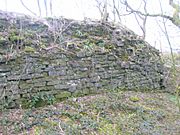
Geology of the Area
The rocks at Spier's are from old lava flows. These are called 'dikes'. The area around Beith has rocks like limestone, coal, and basalt. Basalt comes from volcanic activity.
The basalt at Spier's has many small holes, called 'vesicles'. These formed when gases escaped from the molten rock. You can also see olivine crystals, which show the lava cooled slowly.
Spier's is near limestone quarries like Broadstone and Trearne. Whinstone is still quarried nearby.
DM Beith
A large Defence Munitions (DM) center is located at Beith. It was built in 1943 to store weapons for the Royal Navy. Today, it stores and processes missiles like Spearfish and Tomahawk. Spier's School was within the 'Exclusion Zone' around this site.
Marshalland Burn
This small stream starts from springs at Spier's. It flows under the road and fields before joining the Powgree Burn. During World War II, Polish prisoners of war collected water from the Marshalland Well. A factory nearby used these waters to make fizzy drinks like soda water and lemonade.
The Lands of Roughwood
The Spiersland Way is an old road that leads to Roughwood Farm. Roughwood was once a small fortified tower in the 1400s.
Small Historical Facts
In 1912, the Spier's Trust owned several farms, including Cuff, Marshalland, and Bogstone.
Eglinton Street was once called Whang Street. Robert Spier bought land there in 1826.
The rubble from the demolished school was used to fill an old limestone quarry.
A photograph from 1935 shows a cannon at the front of the school.
The annual Cadger's races in the 1800s were held at the Marshalland Field.
The name 'Pow' or 'Poll' means a slow-moving stream. This fits the Powgree Burn.
The ghost of John Spier was said to roam the school tower. His mother's ghost was said to be in the school grounds.
The Pirritt Hills in Antarctica are named after John Pirritt, a former Spier's student and explorer.
The 1st Beith Company (Spier's) Girl Guides was the only Guides group in Beith in the 1930s. They had a center near the school for some years.
Students who traveled by train often had to leave home very early and return late.
An old map from 1910 shows a 'Sheepwash' near Marshalland farm.
During the 1930s, local people would collect wood from Spier's School for their fires.
A mineral spring called 'Spiers Well' existed near Gatehead in 1789.
The ornate memorial to John Spier was covered up because it made students feel sad.
Donald Reid noted that Mr. W. F. Love of Beith designed the school grounds.
Restoration of Spier's Parklands
The North Ayrshire Council Ranger Service has led efforts to restore the Spier's parklands. Many groups have helped, including local primary schools, The Conservation Volunteers, and Youth Making Beith Better.
Community Involvement at Spier's
In 2008, Beith Community Council organized a clean-up day at Spier's. They removed litter and cleared old paths. Gateside Primary School planted trees and bulbs. Ardrossan Academy students also helped open new paths.
The 'Youth Making Beith Better' group has done a lot of work to improve the grounds. A man named Ken Stewart used his Clydesdale horse, Wesley, to remove fallen logs. This was a great sight for visitors! Geilsland School has also been involved in projects, especially restoring the Coronation Garden.
Friends of Spier's (FoS)
This is a local group that supports the Spier's grounds. They work with The Conservation Volunteers.
The Cuff
The Cuff was an estate that became a farm near Gateside. A stone from 1767 with the Gibson family's names might have come from an older house there. The farm still has beautiful gates and lanes lined with beech trees. Margaret Gibson, John Spier's mother, was an heiress from this family.


